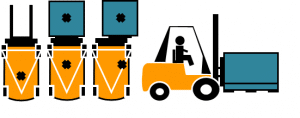Forklift Fundamentals
The ability of a counterbalance forklift to lift and shift a load effectively and safely relies on a constant maintaining of balance between the weight of that load and the counterweight of the machine itself. The fulcrum (or balance point) on a forklift is where the front wheel touches the ground, similar to the axis of a see-saw. Any weight behind the fulcrum is acting as a counterweight, preventing forward tip when the machine lifts a load. Ensuring this balance allows your forklift to perform with optimal stability, which is essential to a safe operation. This may seem simple but many complex factors are at play – some are as follows:
Where Is The Stability Triangle On A Forklift?
The stability triangle is an imaginary triangle of space beneath the forklift between the two front wheels and the center point of the rear axle. The center of gravity for a forklift is not fixed. It shifts as the machine performs different tasks and is influenced by a number of things including its load and centrifugal forces. As long as the center of gravity remains within its stability triangle, the machine will remain stable itself. The closer it moves towards an edge of that triangle, the more the likelihood of it tipping in that direction increases. The center of gravity of an unloaded forklift sits towards the back of the triangle. When it lifts a load, you get a combined center of gravity which is more central, which is why a properly loaded forklift actually has more lateral stability than an unloaded.
How To Calculate Forklift Load Capacity?
Refer to our blog post about Interpreting Your Load Rating Plate for more information. All forklifts have a maximum load weight that they are able to adequately counterbalance. This maximum rating often has constraints on mast position, lift height and load center. As these destabilising factors increase, the load capacity that can be effectively balanced will decrease.
What Does Load Center Mean On A Forklift?
The load center is the balance point of a load where it will be evenly balanced whilst sitting horizontally on tynes with one end of the load butting up against the carriage. This is the point around which the weight of the object is evenly distributed. The further from the face horizontally, and the closer it is to end of tynes, the more the capacity decreases to prevent it from tipping forward. This is why the load center distance record on your Load Rating Plate comes into play, particularly when lifting at extended heights. Operators should be aware of this as one of the factors contributing to stability and need to be aware of the affect it is having on their forklift.
Loss of Stability
If these factors exceed specifications, the balance will be compromised and your forklift will lose either its lateral or longitudinal stability. Typical causes of a loss of lateral or sideways stability include uneven distribution of load, turning at speed, operating on an incline or rough terrain and driving with the load raise or shifted. A number of operations can also cause a longitudinal or forwards tip, including aggressive braking and lifting or driving with load at an extended height. However, a forward tip is almost always caused by some form of overloading the forklift. By simply picking up a load that is too heavy for the counterweight to balance against results in the forklift tipping forwards. It is against regulations to add additional weight to the forklift to increase the counterweight. The second most common way to overload a forklift is by lifting a load that is too long or by not having the load against the heel of the forks. The further the load is moved away from the fulcrum the less weight the forklift is able to lift.
Avoiding a Tip
Taking into account all the above information about forklift stability, there are some easy ways to avoid a tip. Operate within the forklifts specifications. Ensure your load is stable and secure by having balance. Transport loads with tynes low and tilted slightly back.
In the event of a Tip
If your forklift starts to roll sideways, you should remain in the machine, brace your hands and feet and lean against the roll over. Trying to jump from the forklift puts you at great risk of being crushed by the overhead guard against the ground. This is why you should wear your seatbelt where / if it is fitted to prevent operator from falling out.


